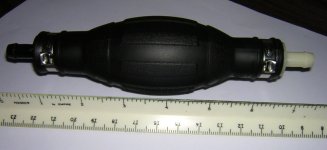S
SFBeerGuy
I am running into a frustrating issue when brewing hoppy ales at home. I am getting a funky/sweet aroma that is reminiscent of bad breath.
It is nothing I have run into before. This aroma is noticeable in the finished product and has been occasionally recorded as far forward as the first day of two of primary fermentation. The aroma (which also shows up a bit in the flavor) has been consistent with the hoppy beers that I make. The hoppier the beer, the more pronounced the aroma/flavor. It also seems to be independent of the types of hops that I use and the types of yeast.
Here are some known variables:
Fermentation temp is rather consistent between 66-70F.
The ales that have displayed this trait so far have used either WLP001, WLP028, SafAle 04 or SafAle 05.
Primary fermentation has been between 5-7days.
OG has been in the 1.067-1.082 range (definitely an estimate).
IBUs have been in the range of 40-78. (ales below 40 have not shown this off-flavor/aroma).
Mash saccrification temps have varied. (all one-step)
I mash in a home-made cooler with a manifold/filter made from the wire mesh from a washing machine tube.
My kettle is 12gal, and to the best of my knowledge, is not stainless.
Primary and secondary fermenters are glass.
I am kegging and force carbonating my ales after time in secondary fermentation.
I have been brewing for a few years now and this is very frustrating to me that I cannot make a highly-hopped ale without the hop flavor and aroma going sour.
I hope someone out there has some incite or at least that I challenged some brewers out there to a new puzzle. Any advise would be appreciated. Keep doing what you all do best and have a hoppy homebrew for me.
Thanks in advance!
Brad
It is nothing I have run into before. This aroma is noticeable in the finished product and has been occasionally recorded as far forward as the first day of two of primary fermentation. The aroma (which also shows up a bit in the flavor) has been consistent with the hoppy beers that I make. The hoppier the beer, the more pronounced the aroma/flavor. It also seems to be independent of the types of hops that I use and the types of yeast.
Here are some known variables:
Fermentation temp is rather consistent between 66-70F.
The ales that have displayed this trait so far have used either WLP001, WLP028, SafAle 04 or SafAle 05.
Primary fermentation has been between 5-7days.
OG has been in the 1.067-1.082 range (definitely an estimate).
IBUs have been in the range of 40-78. (ales below 40 have not shown this off-flavor/aroma).
Mash saccrification temps have varied. (all one-step)
I mash in a home-made cooler with a manifold/filter made from the wire mesh from a washing machine tube.
My kettle is 12gal, and to the best of my knowledge, is not stainless.
Primary and secondary fermenters are glass.
I am kegging and force carbonating my ales after time in secondary fermentation.
I have been brewing for a few years now and this is very frustrating to me that I cannot make a highly-hopped ale without the hop flavor and aroma going sour.
I hope someone out there has some incite or at least that I challenged some brewers out there to a new puzzle. Any advise would be appreciated. Keep doing what you all do best and have a hoppy homebrew for me.
Thanks in advance!
Brad

